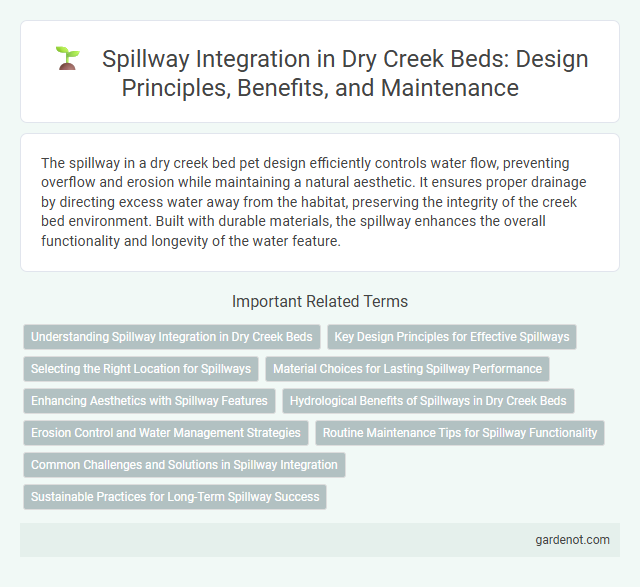The spillway in a dry creek bed pet design efficiently controls water flow, preventing overflow and erosion while maintaining a natural aesthetic. It ensures proper drainage by directing excess water away from the habitat, preserving the integrity of the creek bed environment. Built with durable materials, the spillway enhances the overall functionality and longevity of the water feature.
Understanding Spillway Integration in Dry Creek Beds
Spillways in dry creek beds are engineered to manage water flow during heavy rainfall, preventing erosion and downstream flooding. Proper integration involves designing channels that accommodate sudden water surges while maintaining the natural landscape and allowing sediment transport. Effective spillway placement enhances flood control, stabilizes creek banks, and supports ecological balance in arid watershed areas.
Key Design Principles for Effective Spillways
Effective spillways are designed to manage excess water flow by controlling discharge rates, preventing erosion, and ensuring structural stability. Key design principles include selecting materials resistant to abrasion, optimizing hydraulic capacity to handle peak flood events, and integrating energy dissipation features such as stilling basins or stepped chutes. Proper alignment with the natural dry creek bed morphology minimizes environmental impact while enhancing flood management efficiency.
Selecting the Right Location for Spillways
Selecting the right location for spillways in a dry creek bed involves analyzing topography to ensure efficient water flow management and minimize erosion risks. Engineers prioritize sites with natural depressions or gentle slopes to facilitate controlled overflow during heavy rainfall events. Proper placement enhances flood control, protects infrastructure, and preserves the ecological balance of the surrounding area.
Material Choices for Lasting Spillway Performance
Spillway material choices directly impact durability and erosion resistance in dry creek beds, with concrete and reinforced earthworks offering long-term stability. High-quality, weather-resistant aggregates and erosion control fabrics enhance structural integrity, minimizing maintenance costs. Incorporating geotextiles and natural stone materials further optimizes water flow management while preserving the creek bed's ecological balance.
Enhancing Aesthetics with Spillway Features
Incorporating spillway features into a dry creek bed elevates visual appeal by creating dynamic water flow patterns and textured surfaces. Carefully designed spillways add movement and sound, enhancing sensory experiences while emphasizing naturalistic landscaping. These structures also serve functional roles in controlling runoff, seamlessly integrating utility with aesthetic enrichment.
Hydrological Benefits of Spillways in Dry Creek Beds
Spillways in dry creek beds effectively manage stormwater runoff by controlling water flow during heavy rainfall, reducing erosion and preventing downstream flooding. These engineered structures facilitate groundwater recharge by directing excess water into permeable areas, enhancing aquifer replenishment. Properly designed spillways support sustainable watershed management and improve overall ecosystem health in arid and semi-arid regions.
Erosion Control and Water Management Strategies
Spillways in dry creek beds are engineered to direct excess water flow while minimizing erosion by using durable materials like riprap and reinforced concrete. Effective water management strategies include designing gradual slope transitions and incorporating vegetation to stabilize soil and reduce sediment transport during heavy rainfall. These measures prevent channel degradation and maintain the structural integrity of the creek bed during storm events.
Routine Maintenance Tips for Spillway Functionality
Regularly clear debris such as leaves, branches, and sediment buildup from the spillway to ensure unobstructed water flow and prevent erosion. Inspect the spillway structure for cracks, joint displacements, and signs of wear, repairing any damage promptly to maintain structural integrity. Monitor vegetation growth around the spillway, trimming or removing roots that could weaken the bed's stability and impede water movement.
Common Challenges and Solutions in Spillway Integration
Erosion and sediment buildup often pose significant challenges in spillway integration within dry creek beds, disrupting water flow and structural integrity. Incorporating erosion-resistant materials and regular maintenance schedules effectively mitigates these issues, enhancing durability. Designing adjustable spillway gates can optimize water control, preventing overflow and minimizing ecological impact.
Sustainable Practices for Long-Term Spillway Success
Designing spillways with sustainable materials and erosion control techniques ensures long-term stability in dry creek beds. Incorporating vegetation and permeable surfaces enhances water infiltration and reduces sediment runoff, promoting ecological balance. Regular maintenance paired with adaptive management strategies addresses environmental changes and preserves spillway functionality.
Spillway Infographic

 gardenot.com
gardenot.com